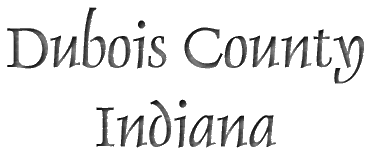

To add additional sources relating to
Dubois County, E-Mail the County Coordinator, Charlie Tredway.
This article appeared in the Family Chronicle • March/April 2007. Thanks
to the Magazine, Halvor Morrshead the Editor & Publisher and the Author
Kathleen Shanahan Maca for allowing its use on the Dubois County Web Page.
FINDING AND DECODING ancient clues has taken on a renewed
popularity with interest in the best-selling Da Vinci Code and television shows like
Treasure Hunters. Even seasoned genealogists may be surprised to find that some secrets of
the dead are right in front of us, if we only know how to read the signs. Since
prehistoric times, humans have adorned final resting places with symbols. Petroglyphs
carved and painted in caves around the world tell stories of everyday lives. Mayan tomb
art portrays terrifying skeletal warnings that echo that culture's fear of death.
Elaborate Egyptian pyramids are filled with signs of deities and the promise of
rebirth.And just recently, it was announced that a 27,000-year-old burial cave (the oldest
of its kind) had been found in France with a series of decorations painted on the walls.
On this continent, dire Puritan warnings of mortality (mostly in
skeleton forms) from two cen-
turies ago slowly evolved into picturesque Victorian expressions of sorrow and hope. Each
reflects the sentiments and beliefs of their own era. Though gravesite adornments are
nothing new to the human race, our memory for their meanings seems quite short in the
tapestry of time. Wander through any old cemetery and you're likely to see designs carved
into the headstones: Some crude, some elaborate. Although it is safe to assume the
meanings of standard images such as a cross (signifying Christianity and resurrection) or
a weeping angel (a symbol of mourning), some are not so easily decrypted. Other than
memento mori (symbols of death and mortality such as skulls, crossbones and hourglasses),
many gravestones icons can be broken down into basic categories.
Images of Nature Fruits and grains of harvest present a clear parallel for the cycle of
life.
• Corn — ripe old age
• Fruits — eternal plenty
• Grapes — blood of Christ, eternal life
• Sheaf of wheat — ripe for harvest, old age, fruitful
life
Flowers and bouquets in general represent sorrow and the fragility of life. Variations
have more specific interpretations: Buds for a life cut short, full rose for prime of life
or a severed stem for a life cut short.Particular flowers usually follow the Victorian
"language of flowers" symbolism.
Bellflower — constancy and gratitude
Calla lily -majestic beauty and , marriage
Daisy — innocence, often on a child's grave
Evening primrose — eternal love, memory, youth, hope and sadness
Garland or wreath — victory in death
Iris — sorrow
Lily, lily of the valley or tulip — innocence, resurrection
Lotus — resurrection, perfect, beauty, spiritual revelation
Morning glory — beginning of life
Pansy — remembrance, meditation
Poppy — eternal sleep
Rose — purity, love
Thistle — Scottish descent or remembrance
• Violet — humility
Animals or related objects, many of which were a part of the deceased,s- everyday life,
represent a variety of beliefs and qualities of character.
• Bee — industrious- ness, Christianity
• Beehive — domestic virtues, education, abundance in heaven
• Butterfly — early death, resurrection
• Caterpillar — life, An engraved lily. metamorphosis